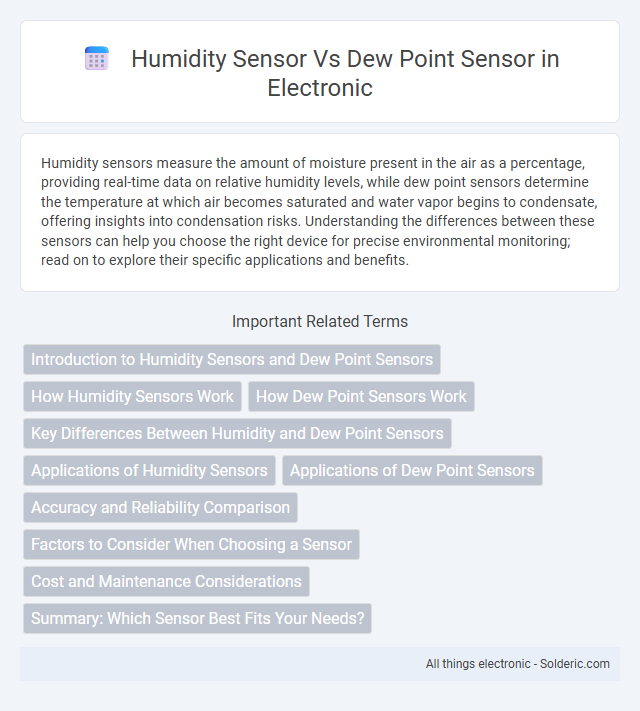Humidity sensors measure the amount of moisture present in the air as a percentage, providing real-time data on relative humidity levels, while dew point sensors determine the temperature at which air becomes saturated and water vapor begins to condensate, offering insights into condensation risks. Understanding the differences between these sensors can help you choose the right device for precise environmental monitoring; read on to explore their specific applications and benefits.
Comparison Table
| Feature | Humidity Sensor | Dew Point Sensor |
|---|---|---|
| Measured Parameter | Relative Humidity (RH) | Dew Point Temperature |
| Function | Measures moisture content in air as a percentage | Measures temperature at which air becomes saturated and condensation forms |
| Applications | HVAC, weather stations, agriculture, industrial processes | Weather forecasting, HVAC control, process monitoring |
| Output Type | Analog or digital (percentage) | Temperature value (degC or degF) |
| Accuracy | Generally +-2% RH | Typically +-0.2 to 0.5degC |
| Response Time | Seconds to minutes | Usually faster, seconds |
| Sensor Technology | Capacitive, resistive, or thermal | Chilled mirror or electronic sensor |
| Cost | Lower to moderate | Moderate to high |
Introduction to Humidity Sensors and Dew Point Sensors
Humidity sensors measure the amount of moisture in the air as a percentage of relative humidity, providing real-time data on atmospheric moisture levels. Dew point sensors determine the temperature at which air becomes saturated and condensation begins, offering precise control for processes sensitive to moisture accumulation. Understanding these sensor types helps you select the right technology for applications like climate control, industrial monitoring, and weather forecasting.
How Humidity Sensors Work
Humidity sensors measure the moisture content in the air by detecting changes in electrical resistance or capacitance caused by water vapor. These sensors often use hygroscopic materials that absorb moisture, altering their electrical properties, which the sensor then converts into humidity readings. Your choice between a humidity sensor and a dew point sensor depends on whether you need general moisture levels or the exact temperature at which condensation begins.
How Dew Point Sensors Work
Dew point sensors measure the temperature at which air becomes saturated and water vapor begins to condense by cooling a surface and detecting condensation formation. They typically use chilled mirror technology or capacitive humidity sensing combined with temperature readings to calculate the precise dew point. This method provides accurate moisture content measurement crucial for industrial processes, HVAC systems, and meteorological applications.
Key Differences Between Humidity and Dew Point Sensors
Humidity sensors measure the amount of water vapor present in the air as a percentage of relative humidity, while dew point sensors determine the temperature at which air becomes saturated and moisture begins to condense. Humidity sensors rely on capacitive or resistive elements to detect moisture levels, whereas dew point sensors use chilled mirror technology or other methods to find the precise temperature of condensation. Your choice depends on whether you need to monitor moisture content or detect condensation risk in applications like HVAC systems or environmental monitoring.
Applications of Humidity Sensors
Humidity sensors are widely used in HVAC systems, agriculture, and industrial processes to monitor and control moisture levels, ensuring optimal environmental conditions. These sensors help prevent mold growth, maintain product quality, and improve energy efficiency by providing real-time data on relative humidity. Your facility can benefit from integrating humidity sensors to enhance comfort, safety, and operational performance.
Applications of Dew Point Sensors
Dew point sensors are essential in industrial HVAC systems, compressed air monitoring, and refrigeration to prevent condensation and maintain optimal humidity control. These sensors provide precise measurements of the temperature at which air reaches saturation, enabling accurate moisture content assessment critical for process control and quality assurance. Their application extends to semiconductor manufacturing, pharmaceuticals, and food processing industries where moisture-sensitive conditions must be rigorously managed.
Accuracy and Reliability Comparison
Humidity sensors measure the moisture content in the air with varying degrees of accuracy depending on the technology, while dew point sensors provide a more precise measurement by directly determining the temperature at which air becomes saturated with moisture. Dew point sensors are generally more reliable for applications requiring exact moisture levels, as they are less affected by temperature fluctuations and sensor drift. For your environment monitoring needs, choosing a dew point sensor ensures higher accuracy and consistency in detecting humidity-related changes.
Factors to Consider When Choosing a Sensor
When choosing between a humidity sensor and a dew point sensor, consider measurement accuracy, response time, and environmental conditions such as temperature and pressure. Humidity sensors measure relative humidity, ideal for general indoor air quality monitoring, while dew point sensors provide precise moisture content in gases, crucial for industrial processes requiring exact dew point control. Your choice depends on the specific application needs, including the required precision, durability, and maintenance demands of the sensor in its operating environment.
Cost and Maintenance Considerations
Humidity sensors typically offer a lower initial cost and require minimal maintenance due to their simple design and fewer moving parts. Dew point sensors, while often more expensive upfront, provide greater accuracy and durability but may demand periodic calibration and more complex upkeep. Your choice depends on balancing budget constraints with the need for precision and long-term reliability.
Summary: Which Sensor Best Fits Your Needs?
Humidity sensors measure the amount of moisture in the air, providing relative or absolute humidity levels, while dew point sensors determine the temperature at which air becomes saturated and condensation begins. If Your application requires monitoring moisture content for comfort, HVAC, or process control, a humidity sensor is ideal; for precise condensation risk assessment in industrial or meteorological contexts, a dew point sensor fits better. Selecting between these sensors depends on whether Your priority is tracking moisture percentage or preventing condensation through temperature thresholds.
humidity sensor vs dew point sensor Infographic

 solderic.com
solderic.com